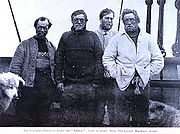
Jameson Adams
Encyclopedia

Antarctic
The Antarctic is the region around the Earth's South Pole, opposite the Arctic region around the North Pole. The Antarctic comprises the continent of Antarctica and the ice shelves, waters and island territories in the Southern Ocean situated south of the Antarctic Convergence...
explorer with the Nimrod Expedition
Nimrod Expedition
The British Antarctic Expedition 1907–09, otherwise known as the Nimrod Expedition, was the first of three expeditions to the Antarctic led by Ernest Shackleton. Its main target, among a range of geographical and scientific objectives, was to be first to the South Pole...
, the first expedition led by Ernest Shackleton
Ernest Shackleton
Sir Ernest Henry Shackleton, CVO, OBE was a notable explorer from County Kildare, Ireland, who was one of the principal figures of the period known as the Heroic Age of Antarctic Exploration...
in an unsuccessful attempt to reach the South Pole. Nevertheless, he was one of the party of four who reached the Polar Plateau for the first time ever, thus showing the way to the Pole. On 9 January 1909 they attained a Furthest South of 88°23′S 162°00′E, just 97 miles (156.1 km) from the South Pole, when they were forced by impending starvation to turn back.
Biography
Born in Rippingdale, Lincolnshire, the son of a doctor and the grandson of a captain in the Indian Navy, he ran away from school to enter the merchant navy at the age of 13. In 1902 he became a sub-lieutenant in the Royal Naval Reserve, and on reaching the rank of Lieutenant he was one of the last to gain a Master Mariner's certificate under sail. But he gave up a promising career to join Ernest Shackleton as the second-in-command of the Nimrod Expedition.On his return from the Antarctic in 1909, he entered the Civil Service, where a year later he was appointed head of the North-Eastern Division of the Employment Exchanges. Recalled to the Navy on the outbreak of the First World War, he became Flag Lieutenant to Admiral Hood commanding the Dover Patrol. Then, after a period of special work at the Ministry of Munitions, he was posted to Flanders to command a battery of naval siege guns. A bad wound in the head necessitated his return in 1917, and he was awarded the DSO and the Croix de Guerre for his services.
After the war, he returned to the Ministry of Labour as Controller for the North-Eastern Division, and such spare time as he had was largely devoted to helping boys' clubs. He left the service in 1935 to become Secretary of King George's Jubilee Trust for youth. He remained in this post, apart from further distinguished service in the Second World War, until his retirement in 1948, when he was knighted. He never actually stopped working; he then became the honorary appeals secretary for King Edward VII's Hospital for Officers, where he worked right up to his death in 1962.
Character and legacy
In appropriate company, his use of somewhat crude invective was often unrestrained, and he was never deterred by convention from saying what he thought. He preferred to be known by allcomers, from porters to the royal family, simply as "The Mate".In November 2008, 100 years after the Nimrod Expedition began, one of "The Mate's" great grandsons, Henry Adams, set off from the Shackleton Hut with two other members of the Shackleton Centenary Expedition http://www.shackletoncentenary.org to complete the whole 800 nautical miles (1,481.6 km) to the South Pole on foot, hauling their own pulks, unassisted. In January 2009, another of "The Mate's" great grandsons, David Cornell, joined the Expedition at the Farthest South 88°23′S 162°00′E to complete the last 97 miles (156.1 km) of unfinished family business.

